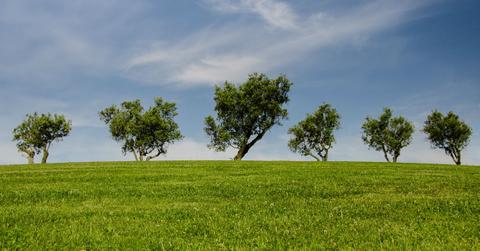What's The Green New Deal?
Alexandria Ocasio-Cortez and other progressive politicians are pushing for this legislation. But what does it do?
Updated Dec. 4 2018, 1:07 p.m. ET
They won’t officially take office until January 2019, but the newest members of Congress are already making headlines. You’ve likely heard a lot about Alexandria Ocasio-Cortez, who — at 29 — has become the youngest woman ever elected to Congress. The Democratic representative from New York spent her first day of orientation protesting with climate change activists in the Cannon House Office Building, and since then, she’s been talking a ton about something called the “Green New Deal.”
The Green New Deal now has the support of nine other current or incoming members of Congress — Carolyn Maloney, José Serrano, Ro Khanna, Rashida Tlaib, Ilhan Omar, Deb Haaland, Joe Neguse, Ayanna Pressley, and John Lewis. But what exactly is it and what will it do? The proposed plan would completely remake our national grid, switching over to 100 percent renewable energy and decarbonizing multiple American industries. But there’s a lot more to it than that, and a lot more still to be determined. Here are some of the basics:
The Green New Deal would drastically reduce U.S. carbon emissions
You likely remember the original New Deal from history class. That package of public programs and initiatives was designed to stabilize the economy after the Great Depression, providing new opportunities to unemployed Americans. The Green New Deal is also seeking to stabilize — in this case, the climate.
Ocasio-Cortez is calling for a 15-member committee to develop and execute a Green New Deal. Since climate scientists have given us as little as 12 years to mitigate the effects of climate change, the plan would work on a speedy deadline. As outlined on Ocasio-Cortez’s website, the committee would have one year to draw up the plan, and once enacted, the Green New Deal would be expected to achieve the following goals within 10 years:
That’s a highly ambitious list, but the goals don’t stop there. The draft text also paints the Green New Deal as a “historic opportunity to virtually eliminate poverty in the United States” and calls for a job guarantee program, universal healthcare, and an end to racial and gender-based income inequalities. The plan must, the text says, “take into account and be responsive to the historical and present-day experiences of low-income communities, communities of color, indigenous communities, rural and urban communities and the front-line communities most affected by climate change, pollution and other environmental harm.”
Missing from the outline is the how of it all — the funding, legislation, and policies required to execute the Green New Deal. That would be the committee’s challenging task, to be completed by Jan. 1, 2020.
The public supports the Green New Deal, but Congress may not
As The Huffington Post notes, voters are on board with the basic tenets of the plan. In a recent survey, 46 percent of respondents said they strongly supported levying taxes on companies that emit large amounts of greenhouse gases, and 38 percent said they strongly support giving unemployed Americans jobs building “energy-efficient infrastructure.” Back in May, the Pew Research Center also reported that 59 percent of Americans say climate change affects their local community.
But some of Ocasio-Cortez’s peers have cast doubt on the plan, either questioning its feasibility or suggesting Congress revive a former select committee on climate change instead. Political analysts also expect Republicans to object to the (presumably) high budget of the Green New Deal. Still, the outcome is mostly speculation until Ocasio-Cortez’s first session of Congress commences next January, ushering in a new class of environmentally-minded politicians.
